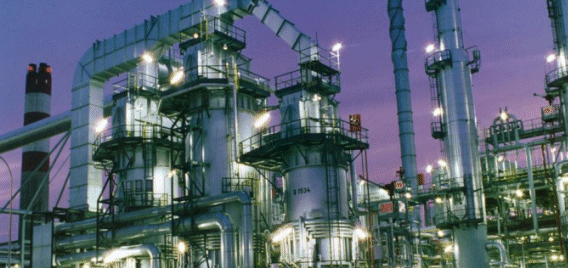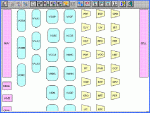Chemical and Process Engineering Resources

Model Input
Once all the static data is configured, the model is updated with the variable data in model for solving a particular problem. The common variable data required includes:
- Crude oil or any other raw material prices and minimum and maximum availability
- Selling prices and minimum and maximum demands for the different finished goods
- Available process unit capacities
- Available Inventory stocks and minimum and maximum storage limits
- Quality specifications, etc.
User Interface
  |
| Figure 3: RPMS Graphical User Interface |
LP software commercially available today is highly advanced with features to provide a maximum user-friendly experience. RPMS has a powerful Graphical User Interface (GUI), which provides a highly effective and intuitive interface for working with the model. It contains a model navigation window with graphical objects. The graphical objects contain information on Charge Yields, Feeds, Products, Results, etc.  Data and Report factory is an integrated application of RPMS for input of static and variable data and generating standard reports in Excel (Fig. 3.0 provides a glimpse of a GUI for a refinery LP model).
The LP matrix generator transforms the input data into a great number of equations and variables.  The LP optimization algorithm solves the matrix and calculates which combination of supply, processing, blending and selling activities gives the highest margin. The LP reporting system reports this optimal combination of activities, together with the financial results. The output is generated in the form of different types of text and Excel files. RPMS has a powerful report factory utility for generating various customized Excel reports. The reports contain detail output with respect to crudes quantities, product numbers, capacity utilization, power, utilities and chemical consumption levels. The outputs also provide valuable information like reduced cost, pi values, DJ values, etc.
For further information on RPMS, explore the RPMS link listed under References.
Traditional Limitation and Advancements in Linear Programming
The LP modeling has changed substantially. The static yield-driven models with fixed stream properties have now been replaced by variable property-driven models using latest non-linear distributive recursion techniques.  Swing cuts for cut-point optimization have been semi-automated using implicit pooling techniques. Multi-period and multi-refinery modeling capabilities have been enhanced. The linkage of crude assay data into the LP assay tables has been enhanced and automated. Process unit representations have changed from multiple “mode†type yield structures to base-delta vector yield representations.
In a nutshell, current LP systems offer embedded process simulation and other non-linear representation capabilities to provide even more accuracy and realism for refinery LP representations. The LP technique is far superior when compared to any Excel programs traditionally used for planning. However, it is worthwhile to keep in mind certain limitations of LP in order to appreciate the LP solutions:
- Non-linear nature of refinery processes: The nature of the refining processes is mainly non-linear whereas linear programming - as the name already suggests - assumes that a linear combination of the provided options is valid. RPMS uses a specialized recursion technique called Successive Linear Programming (SLP) for modeling and solving non-linear problems.  For most of these, engineers have developed "linear blend indices," which transform the measured qualities into index values, which can be constrained using ordinary linear constraints.
- Data overload: While developing the model, providing all the possible processing options is impossible. Increasing the number of variables and constraints increases the efforts to maintain the database and the difficulty to maintain the required data consistency. It also reduces the system’s transparency, therefore increasing the chances of big errors in data and logic. RPMS has a powerful interface with Excel and tools like Fast Data Import, model comparison, etc. to minimize the data errors.
- LP does not consider the elements of time and storage: It assumes that all activities occur simultaneously and that all identified components are separately available for further processing or blending (like there are separate tanks available for all individual components). A refinery may process HS and LS crudes in a blocked-out fashion, whereas an LP model mixes HS and LS crudes simultaneously. This limitation is addressed by reducing the time bucket while making the plan and using multi-period models. Weekly planning methodology can be used for making plans closer to actual operations and address scheduling issues.Â
- LP exercises no judgment: One point must always be remembered: “LP Models are just as good as the data put in and the assumptions used to create them. Models should not replace good and sound engineering judgment.â€Â The LP requires quality input data in order to provide workable and practical solutions. Yield and property data are based on plant measurements and rule-of-thumb calculations or estimations. Pricing data used is often based on the statistical average of past months or years. Based on the input data only, the LP model solves the problem and it exercises no judgment. A small change in one piece of data may result in a completely different solution, and will ignore all uncertainties and risks to achieve just a minor increase in profits. This problem has been tackled by sensitivity analysis where many cases can be run using Model Modifier (MMOD) feature of RPMS and arriving at practical and implement-able solutions.
Energy Articles

 FB
FB


1 Comments